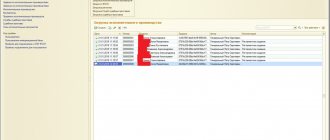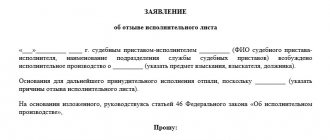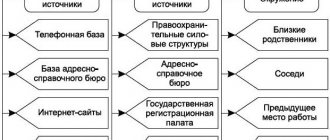Reports that the manager or accountant of a particular enterprise has been brought to administrative or even criminal liability for violating the procedure for withholding alimony from an employee appear in reports from various law enforcement agencies with alarming frequency. The geography of such offenses is very vast - from Moscow to Magadan, as the popular song says. If we abstract from the presence or absence of malicious intent, this indirectly indicates that not all accountants are properly aware of the nuances associated with withholding alimony. That is, despite the fact that this topic has seemingly been studied far and wide, not everything is as “nutritious” as it seems. And here they are preparing more innovations. Let's fill in some gaps. Let's start with responsibility.
Read also “Procedure for withholding alimony”
Responsibility for concealing employee income
Yes, yes, this is most likely how the actions of an accountant who made a mistake when withholding alimony are qualified. In addition to the timely deduction of alimony from the salary of an employee “sentenced” to this (Article 109 of the RF IC), the employer is also responsible for notifying the bailiff (recipient of alimony) about the dismissal of the debtor and about his new place of work (if known).
For failure to comply with these requirements, the company and its officials may be subject to administrative liability. The fine under Article 19.7 of the Code of Administrative Offenses of the Russian Federation - “Failure to provide information (information)” does not seem particularly burdensome: for citizens - from 100 to 300 rubles; for officials – from 300 to 500 rubles; for legal entities – from 3,000 to 5,000 rubles. For the first time, inspectors may limit themselves to a warning.
But the sanctions enshrined in paragraph 3 of Article 17.14 of the Code of Administrative Offenses of the Russian Federation “Violation of legislation on enforcement proceedings” are already noticeably tougher: for citizens - from 2000 to 2500 rubles; for officials – from 15,000 to 20,000 rubles; for legal entities – from 50,000 to 100,000 rubles.
But that's not all. Officials of an organization for malicious failure to comply with the requirements contained in executive documents or for obstructing their execution (failure to withhold and transfer alimony) may be held liable under Article 315 of the Criminal Code of the Russian Federation - “Failure to comply with a court sentence, court decision or other judicial act.”
That is why an accountant involved in withholding alimony must clearly know and understand all the nuances of working with writs of execution, as well as the procedure for calculating and transferring alimony.
The set of sanctions is as follows:
- fine: in the amount of up to 200,000 rubles or in the amount of wages or other income of the convicted person for a period of up to 18 months;
- deprivation of the right to hold certain positions or engage in certain activities for a period of up to five years;
- compulsory work for up to 480 hours;
- forced labor for up to two years;
- arrest for up to six months;
- imprisonment for up to two years.
The bailiff will warn company representatives about criminal liability for the transfer of alimony not in full or their untimely withholding, as well as for concealing or understating the debtor’s income in writing, approved by Order of the Federal Bailiff Service of Russia dated December 15, 2016 No. 635.
When a warning is presented, the bailiff will take a receipt from the manager or other authorized person stating that the above-mentioned article of the Criminal Code of the Russian Federation has been explained and understandable to him, and, as they say, will wash his hands.
The company’s primary task is to check the correctness of the execution documents.
Read also: “Bailiffs will be allowed to detain alimony workers”
We check executive documents
Withholding of alimony is made on the basis of the following documents:
- writ of execution (form approved by Decree of the Government of the Russian Federation dated July 31, 2008 No. 579), which is issued on the basis of a court decision. Alimony can be collected in a fixed amount, in a share of the employee’s income, or simultaneously in shares and in a fixed amount;
- court order (a decision made by a single judge based on an application for the recovery of monetary amounts). In this case, alimony is collected only as a share of the employee’s income;
- an agreement on the payment of alimony concluded between the alimony payer and the recipient.
Each of these documents should be checked for compliance with legal requirements.
Performance list
This is a document issued by the court that states the reason and amount of deductions from the employee. Withholding under a writ of execution is possible only if it contains all the required details:
- name of the court that issued the sheet;
- number of the court case for which the sheet was issued;
- the date of the court decision to withhold funds from the employee;
- statement of the decision of the judicial authority;
- date of entry into force of the court decision;
- date of issue of the sheet;
- the name of the debtor and the person in whose favor the collection is being carried out.
The writ of execution is signed by the judge and certified with the official seal. Withholding of amounts of money from an employee’s income on the basis of a writ of execution is carried out without issuing an order from the manager on withholding and without the consent of the employee.
After the writ of execution is received by the organization, it must be registered and no later than the next day submitted against receipt to the accounting department.
In accounting, all executive documents are registered in a special journal and stored as strict reporting forms.
Agreement
If with a writ of execution (must contain the mandatory details listed in Article 13 of the Federal Law of October 2, 2007 No. 229-FZ “On Enforcement Proceedings” (hereinafter referred to as Law No. 229-FZ)) and a court order (the requirements for it are established by Article 127 of the Code of Civil Procedure of the Russian Federation) usually everything is in order, since they are issued by the court, then the verification of the agreement must be approached more thoroughly.
Thus, the agreement must be concluded in writing and certified by a notary (clause 1 of article 100 of the RF IC). Changes made or termination of the agreement are also certified by a notary. The document must comply with the requirements of Chapter 16 of the Family Code and contain:
- amount of alimony;
- the procedure for indexing the amount of alimony;
- methods and procedure for payment.
Let us remind you that alimony can be paid:
- in shares of the earnings (other income) of the alimony payer;
- in a fixed amount of money periodically or at a time;
- by providing property or other means (clause 2 of article 104 of the RF IC).
The agreement may provide for a combination of different methods of paying alimony.
Writs of execution can be presented for execution during the entire period for which alimony is awarded, as well as within three years after the end of this period (Part 4 of Article 21 of Law No. 229-FZ).
Debtor search
If the alimony does not have a known source of income and does not appear when called, the bailiff takes measures to find him. Initially, the debtor is searched for at his place of registration. If it is not there, the specialist should check other known addresses - parents, relatives, acquaintances, etc.
To search for the debtor and establish the property belonging to him, the bailiff sends requests:
- to the bank whose client is the debtor, as well as to other financial organizations in order to identify accounts and deposits;
- in the traffic police;
- to Rosreestr;
- to the Pension Fund;
- to the information desk of the Central Internal Affairs Directorate;
- to the tax service.
Notifying interested parties
Documents can be sent to the organization either by the claimant himself or by the bailiff. When a document is sent to a company by a claimant, he must also attach a statement to it (Article 9 of Law No. 229-FZ) with the following data:
- bank account details or address for transfer;
- Full name of the claimant and details of the identity document;
- TIN.
If the claimant handed over the writ of execution to the bailiff service, then the organization will receive the order of the bailiff and a copy of the writ of execution.
The organization is obliged to notify the claimant (the person in whose favor the deductions are made) and the bailiff on the day of receipt of the papers about the receipt of the writ of execution.
The notification makes a note about receipt of the writ of execution (incoming number and date), indicates the telephone number of the organization, and also puts the signature of the accountant and the seal of the organization.
In addition, the employer is obliged to notify the bailiff (collector) within three days about the dismissal of the alimony payer, about his new place of work (if known) and return the writ of execution with a note on the penalties made. The mark indicates:
- amount of deductions and amounts withheld;
- numbers of payment orders (receipts);
- dates of transfers and balance of debt (if any).
Sometimes enforcement documents come to the organization when the alimony payer has already quit. In this situation, the employer is also obliged to inform about the payer’s new place of work (if it is known) and return the papers to the sender within three days.
If the start date of alimony collection falls during the period of the alimony payer’s work in the organization, then a covering letter should be attached to the documents.
It indicates the date of dismissal of the employee and his income from the date when it was necessary to begin withholding alimony (indicated in the writ of execution) to the date of dismissal, as well as the amount of personal income tax withheld for this period.
Measures to collect funds
As effective measures to encourage the payer to close the debt, bailiffs have the right to apply the following measures:
- ban on leaving the country;
- restriction on the right to use a vehicle (except for cases when driving it is the only source of income);
- seizure of bank accounts;
- seizure of property with the possibility of selling it at auction to pay off the debt;
- wanted notice for a debtor who is hiding his place of residence.
How much alimony should be paid?
According to paragraph 1 of Article 81 of the Family Code, the amount of alimony for the maintenance of minor children, collected in court, is:
- for one child – 1/4 of monthly income;
- for two children – 1/3 of monthly income;
- for three or more children – 1/2 of the monthly income.
The size of these shares may be reduced or increased by the court, taking into account the financial or marital status of the parties and other noteworthy circumstances (Clause 2 of Article 81 of the RF IC).
note
Men who owe money to their former “halves” and children, who by definition are only “real”, are a fairly common occurrence. But HR officers and accountants should take a closer look at personnel who fall under the definition of the “weaker sex.” In Buryatia, for example, according to the Federal Bailiff Service of the Russian Federation, every fifth child support worker is a woman. A terrible age, terrible hearts, as a poet would say.
The court has the right to establish the amount of alimony in a fixed sum of money if the payer’s income is irregular, variable, or the salary is calculated in foreign currency, etc. (Article 83 of the RF IC).
When concluding an agreement on the payment of alimony, the parties independently determine the amount of alimony. However, it cannot be less than the amount that could be obtained by collecting alimony in court.
Let us remind you that the total amount of deductions from wages cannot exceed 20% (Part 1 of Article 138 of the Labor Code of the Russian Federation). However, there are exceptions. Thus, the amount of deductions increases to 50% of wages and other income when collected under several enforcement documents (clause 2 of Article 99 of Law No. 229-FZ).
And when collecting alimony for minor children, compensation for harm caused to health, compensation for harm in connection with the death of a breadwinner and compensation for damage caused by a crime, the amount of deductions from wages and other income can be increased to 70% (clause 3 of article 99 of Law No. 229-FZ).
The amount of deductions from an employee’s salary is calculated from the amount remaining after taxes are withheld (letter of the Ministry of Health and Social Development of Russia dated November 16, 2011 No. 22-2-4852).
When withholding alimony from an employee who has worked part-time due to absenteeism, the amount of alimony is determined based on his salary calculated for a full working month.
By agreement between the parents, one of them can be provided with a “children’s” deduction in double amount, while the other may not be provided with it. To do this, you need to write appropriate statements to the accounting department.
The only parent (adoptive parent), guardian, trustee is provided with a double “children’s” deduction.
The last month for providing a double deduction is the month of marriage (subclause 4, clause 1, article 218 of the Tax Code of the Russian Federation).
How to take into account
To account for mandatory deductions, open a subaccount for account 76 “Settlements under executive documents”. When withholding certain amounts under enforcement documents, make an entry in your accounting:
Debit 70 Credit 76 sub-account “Settlements based on executive documents”
— funds are withheld according to the writ of execution from the employee’s wages.
When paying the withheld funds to the claimant from the cash register, make the following entry:
Debit 76 subaccount “Settlements on executive documents” Credit 50-1
— the withheld amount is issued to the recipient from the cash register.
When transferring the withheld funds to the bank (settlement) account of the creditor, make the following entry:
Debit 76 subaccount “Settlements on executive documents” Credit 51
— the withheld amount is transferred to the bank (settlement) account of the claimant.
If the withheld amount is transferred by mail, make an accounting entry:
Debit 57 Credit 50-1
— the withheld funds are handed over to the post office for forwarding to the claimant.
After receiving a notification from the post office about the receipt of funds by the creditor, an entry is made in the accounting:
Debit 76 subaccount “Settlements on executive documents” Credit 57
— the withheld amount received by the claimant is written off.
Stages of participation of the collector in interaction with the bailiff
Let us highlight the main stages of what needs to be done to effectively collect alimony:
- Receive a document confirming your right to receive payments.
- Write an application to the bailiff department to initiate enforcement proceedings.
- Having made sure that enforcement proceedings have been initiated, if possible, provide the contractor with comprehensive information about possible options for debt collection (where he works, the presence of deposits in bank accounts, etc.).
- If the resolution of the issue on the merits does not move forward, request documents on enforcement proceedings from the bailiff.
- In case of reconciliation with the ex-spouse and the problems are resolved peacefully, you can revoke the writ of execution.
Calculation and payment of alimony
Alimony is withheld from all types of wages (monetary remuneration, maintenance) and additional remuneration received by the payer. The list of types of wages and other income from which alimony for minor children is deducted (hereinafter referred to as the List) was approved by Decree of the Government of the Russian Federation of July 18, 1996 No. 841. This document also contains a list of payments from which alimony is not deducted. In addition, the types of income from which alimony should not be withheld are specified in Article 101 of Law No. 229-FZ.
Please note that the Determination of the Constitutional Court of the Russian Federation dated January 17, 2012 No. 122-О-О states that alimony cannot be collected from income received by the alimony payer outside of connection with his economic or labor activities. Thus, it is impossible to withhold alimony, for example, from the income received by the payer from the sale of real estate.
note
Within three days after the dismissal of the employee, the writ of execution is handed over to the bailiffs. If your company does not do this or violates the deadline for submitting a writ of execution, then it can be fined in the amount of 50,000 to 100,000 rubles, and the manager or chief accountant - from 15,000 to 20,000 rubles (Part 3 of Article 17.14 of the Code of Administrative Offenses of the Russian Federation).
Alimony should be withheld from the employee’s salary from the date specified in the writ of execution. Collection of alimony is made after deduction of personal income tax from the employee’s income. Let us remind you that alimony is not subject to personal income tax (clause 5 of article 217 of the Tax Code of the Russian Federation).
Thus, the calculation is made using the following formula.
Formula for calculating alimony
At the same time, the accountant, when calculating personal income tax, must take into account whether the alimony payer has the right to receive a standard deduction for a child (subclause 4, clause 1, article 218 of the Tax Code of the Russian Federation). The right of the alimony payer to receive this deduction is confirmed by the fact of payment of alimony or the availability of documents confirming expenses for children made in accordance with the agreement, as well as by providing the organization with the child’s birth certificate, divorce certificate, writ of execution (letter from the Ministry of Finance of Russia dated May 30, 2011 No. 03-04-06/1-125, dated 10.11.2012 No. 03-04-05/8-1179, dated 03.23.2012 No. 03-04-05/8-367.
There are situations when an organization receives several executive documents. Here the accountant should determine in what order to satisfy the requirements contained in them, and based on these data, make calculations. So, first of all, the requirements are satisfied (clause 1, part 1, article 111 of Law No. 229-FZ):
- for the collection of alimony;
- compensation for harm caused to health;
- compensation for damage in connection with the death of the breadwinner;
- compensation for damage caused by the crime;
- compensation for moral damage.
Accordingly, if the requirements contained in the second writ of execution, as well as alimony, are collected in the first place, then they are satisfied proportionally between the claimants. The total amount of deductions cannot exceed 70% of the employee's income. If the amount withheld is not sufficient to satisfy all requirements, the remaining amounts are carried over to the next month.
If the requirements contained in the executive documents relate to different queues, then alimony is withheld first, and then other requirements are satisfied. In this case, the total amount of deductions cannot exceed 50% of the employee’s income. The withheld amount may not be enough to satisfy the requirements under the second writ of execution, so the remaining amount is transferred to the next month.
The organization is obliged to transfer alimony no later than within three days from the date of payment of wages to the alimony payer (Article 109 of the RF IC, Part 3 of Article 98 of Law No. 229-FZ). Alimony can be transferred to the recipient by mail or to his current account. Details for the transfer are indicated in the writ of execution (in the application attached to it) or in the order of the bailiff to foreclose on the debtor's income. The transfer of alimony is made at the expense of the debtor.
If the address of the recipient is unknown, it is recommended to transfer alimony to the current account of a structural unit of the territorial body of the FSSP.
Alimony under a writ of execution and a court order is collected until the child reaches the age of majority. Payments are terminated only in the following cases:
- death of the payer or recipient of alimony;
- adoption of a child;
- acquisition by a minor child of full legal capacity before reaching adulthood (marriage, emancipation).
Payment of alimony under the agreement is terminated upon expiration of its validity period, as well as in connection with the death of the recipient or payer of alimony, or on other grounds provided for by the agreement.
EXAMPLE.
CALCULATION OF ALIMONY The accountant of Aktiv JSC, on the basis of a writ of execution, withholds 1/4 of K.B.’s income.
Yakovlev to pay alimony. Yakovlev’s salary in the reporting year is 15,500 rubles. per month. He receives a monthly bonus for length of service in the amount of 800 rubles. When calculating personal income tax, Yakovlev uses a child deduction in the amount of 1,400 rubles. The organization pays contributions for insurance against industrial accidents and occupational diseases at a rate of 3.1%, and contributions for OPS, OSS and compulsory medical insurance - at a rate of 30%. The amount of personal income tax withheld from Yakovlev will be: (15,500 rubles + 800 rubles - 1,400 rubles) × 13% = 1937 rubles. Amount of income, with for which alimony is withheld will be: 15,500 rubles. + 800 rub. – 1937 rub. = 14,363 rubles. The Aktiva accountant must withhold alimony from Yakovlev in the amount of: 14,363 rubles. × 1/4 = 3590.75 rubles. Next, the Asset accountant will make the following entries: Debit 20 Credit 70
- 16,300 rubles.
(15,500 + 800) – Yakovlev’s salary and long-service bonus were accrued; Debit 20 Credit 69-1-2
- 505.3 rub.
(RUB 16,300 × 3.1%) – premiums have been charged for insurance against industrial accidents and occupational diseases; Debit 20 Credit 69
- 4890 rub.
(RUB 16,300 × 30%) – contributions for compulsory health insurance, compulsory health insurance and compulsory medical insurance are accrued; Debit 70 Credit 68 subaccount “Calculations for personal income tax”
- 1937 rubles.
– personal income tax was withheld from Yakovlev’s income; Debit 70 Credit 76 subaccount “Settlements based on writs of execution”
- 3590.75 rubles.
– the amount of alimony under the writ of execution is withheld; Debit 70 Credit 50-1
- 10,772.25 rubles. (16,300 – 1937 – 3590.75) – Yakovlev’s salary and long-service bonus were issued from the cash register (minus the amount of deductions).
Debt collection by bailiffs: how does it work in Russian realities?
Based on the provisions of Art. 35 No. 229-FZ, bailiffs can conduct various events between 6 a.m. and 10 p.m. strictly on weekdays. No one can harass the debtor on holidays and weekends: neither bailiffs, nor collectors, nor creditors: banks or microfinance organizations.
In practice, bailiffs often visit citizens in the morning - at 6-8 o'clock. This is much more effective than conducting evening raids; people are most often at home at 6 am.
The following collection rules apply:
- Visiting a residential apartment or other premises without the consent of the owner. The civil servant conducting such a raid must have permission from the senior bailiff to carry out the activity.
- The seizure of property is carried out only with the participation of witnesses. At the same time, they must sign a document drawn up based on the results of the arrest.
When visiting a debtor at his place of residence, bailiffs can describe almost everything that is in the apartment or house. In particular:
- household appliances;
- furniture;
- automobile;
- other expensive objects and items. For example, an antique striking clock.
In such a situation, relatives of debtors often object to the “arbitrariness” of the FSSP. But bailiffs are allowed to describe property thanks to Art. 119 No. 229-FZ.
If the debtor's relatives or other interested parties do not agree with the measures taken by the bailiffs, they can go to court to prove the ownership of the described property through:
- witness statements;
- contracts, for example, donations;
- receipts and receipts for the purchase of these items.
It is necessary to take into account the provisions of Art. 446 of the Code of Civil Procedure of the Russian Federation, which provides a list of objects not subject to collection. Bailiffs cannot take away, regardless of the origin and amount of the debt:
- the debtor's apartment, if it is his only one. But the bailiffs can impose a seizure on the right to dispose of a single apartment. It cannot be sold, mortgaged or donated;
- a car or other vehicle, if the debtor is disabled with mobility restrictions. For example, he has no leg or is diagnosed with cerebral palsy;
- a plot of land on which a house is built, recognized as the only dwelling;
- personal belongings of the debtor;
- Food;
- household items and other similar things.
As for household appliances, the situation here is ambiguous. Bailiffs recognize the immunity of:
- refrigerator;
- kitchen stove.
The washing machine is described according to the situation: if the family has young children or disabled people, it will also be recognized as property that is necessary for the debtor’s family. In this case, it will not be described. As for computer equipment and laptops, as a rule, they are subject to description. The exception is when the debtor works on a PC: for example, when he is a graphic designer.
We have already found out that the only housing will not be taken away under any circumstances. True, the Constitutional Court made a reservation in April 2021. He allowed the courts to seize and sell in bankruptcy the only luxury housing. For example, if the debtor has housing with an area of 100 square meters. And especially if such housing was purchased after the person incurred debts that he did not repay to creditors. The position of the Constitutional Court in August 2021 was also supported by the Supreme Court of the Russian Federation.
But the only apartment that is not subject to seizure cannot be considered a mortgaged apartment, even if the debtor has children, and besides this apartment he has no other housing or property. Bailiffs can seize and sell such housing.
How to store executive documents
Executive documents are recorded and stored as strict reporting documents. Thus, a document received by an organization should be registered in the incoming correspondence journal and submitted to the accountant against signature. It is worth noting that it is best to appoint an accountant, by appropriate order, as responsible for storing executive documents.
To control the movement of papers in the accounting department, you should create a log of executive documents, in which the accountant will record the received documents. The journal form is not approved and can be developed independently. For example, it may contain the following columns:
- date of receipt and incoming number;
- document number, when and by whom it was issued;
- Full name and address of the alimony payer;
- Full name and address of the claimant;
- the amount of monthly deductions;
- retention period;
- debt;
- date of dismissal of the debtor;
- date of return of the writ of execution (to the bailiff, to the recipient of alimony).
Documents must be stored in safes, metal cabinets or special rooms to ensure their safety (clause 6.2 of the Regulations on Documents and Document Flow in Accounting, approved by the USSR Ministry of Finance on July 29, 1983 No. 105). An official guilty of the loss of a writ of execution may be subject to a fine of up to 2,500 rubles (Article 431 of the Code of Civil Procedure of the Russian Federation).
Read also “Storage of personnel documents”








